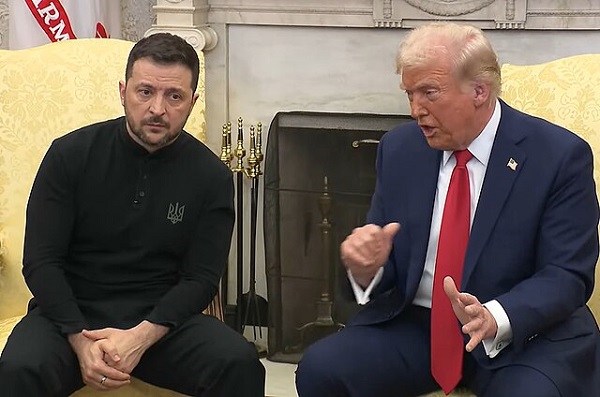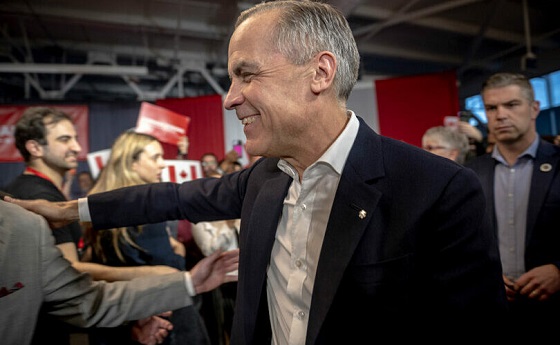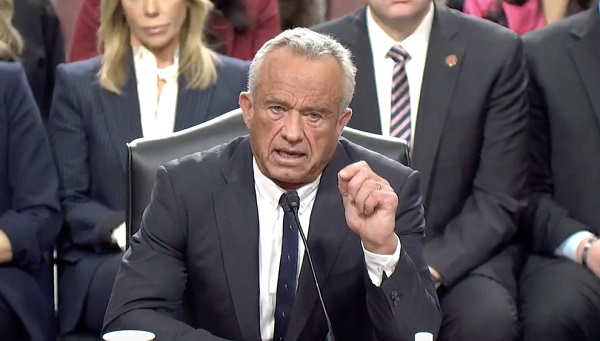International
Trump AG nominee Pam Bondi: ‘Sending informants into Catholic churches must stop’

From LifeSiteNews
Garland’s DOJ targeted Christians, including Catholics, as shown by the FBI’s infamous memo issued from its Richmond, Virginia office declaring that so-called “Radical Traditionalist Catholic Ideology” is a magnet for “violent extremists”
Pam Bondi, President-elect Donald Trump’s nominee for attorney general, pledged Wednesday during her Senate confirmation hearing to put an end to the Department of Justice’s targeting of Catholics and of anyone for their “faith” or exercise of peaceful protest.
On the first day of the confirmation hearing for the former Florida Attorney General, Republican Sen. Mike Lee of Utah asked Bondi how she would “prevent the weaponization” of the DOJ against Americans, including the targeting of “Catholics attempting to practice their faith,” parents speaking out at school board meetings, and those peacefully protesting outside of abortion facilities.
“Going after parents at a school board meeting has got to stop,” Bondi said, adding that so must the targeting of Americans “for practicing your religion.”
“Sending informants into Catholic churches must stop,” she told Lee.
Republican Sen. Josh Hawley of Missouri also highlighted the “unprecedented attack and campaign against people of faith” that has occurred under President Joe Biden’s DOJ, citing the “over 100 pregnancy care centers and over 300 churches that were attacked, vandalized, (and) firebombed” during Biden’s term.
“We’ve never seen anything like it before in American history. It has been one of the most disgraceful chapters in American history,” remarked Hawley, according to whom only two of these crimes were prosecuted under Attorney General Merrick Garland.
Hawley pointed out that, meanwhile, Garland’s DOJ targeted Christians, including Catholics, as shown by the FBI’s infamous memo issued from its Richmond, Virginia office declaring that so-called “Radical Traditionalist Catholic Ideology” is a magnet for “violent extremists,” and expressing interest in recruiting Catholics to spy on fellow churchgoers who attend the Traditional Latin Mass.
Asked by Hawley whether she would put an end to “abuses” like this memo, Bondi replied, “Of course,” adding, “I think what you’re talking about is the ultimate weaponization (of government),” Catholic News Agency reported.
Hawley also asked Bondi whether she would investigate the federal agents involved in the memo. She assured him she “will personally read that memo” and discuss it with Kash Patel, Trump’s nominee to head the FBI.
Bondi was Florida’s Attorney General from 2011 until 2019, serving under then-Florida Gov. Rick Scott, who is now a U.S. senator. In 2014, she took a strong public stance in defense of marriage. She has also targeted child trafficking and was floated as a possible replacement for Jeff Sessions during Trump’s first term.
In 2012, Bondi sued the Obama administration to overturn its mandate that religious employers provide contraception, sterilization, and abortifacients to their employees as part of their health care plans. She also defended Florida’s pro-life protections.
Her selection as AG nominee came after Matt Gaetz withdrew from consideration when it was clear that GOP Senators Mitch McConnell, Lisa Murkowski, and Susan Collins and Senator-elect John Curtis of Utah would not vote to confirm him.
Automotive
Hyundai moves SUV production to U.S.

 MxM News
MxM News
Quick Hit:
Hyundai is responding swiftly to 47th President Donald Trump’s newly implemented auto tariffs by shifting key vehicle production from Mexico to the U.S. The automaker, heavily reliant on the American market, has formed a specialized task force and committed billions to American manufacturing, highlighting how Trump’s America First economic policies are already impacting global business decisions.
Key Details:
-
Hyundai has created a tariffs task force and is relocating Tucson SUV production from Mexico to Alabama.
-
Despite a 25% tariff on car imports that began April 3, Hyundai reported a 2% gain in Q1 operating profit and maintained earnings guidance.
-
Hyundai and Kia derive one-third of their global sales from the U.S., where two-thirds of their vehicles are imported.
Diving Deeper:
In a direct response to President Trump’s decisive new tariffs on imported automobiles, Hyundai announced Thursday it has mobilized a specialized task force to mitigate the financial impact of the new trade policy and confirmed production shifts of one of its top-selling models to the United States. The move underscores the gravity of the new 25% import tax and the economic leverage wielded by a White House that is now unambiguously prioritizing American industry.
Starting with its popular Tucson SUV, Hyundai is transitioning some manufacturing from Mexico to its Alabama facility. Additional consideration is being given to relocating production away from Seoul for other U.S.-bound vehicles, signaling that the company is bracing for the long-term implications of Trump’s tariffs.
This move comes as the 25% import tax on vehicles went into effect April 3, with a matching tariff on auto parts scheduled to hit May 3. Hyundai, which generates a full third of its global revenue from American consumers, knows it can’t afford to delay action. Notably, U.S. retail sales for Hyundai jumped 11% last quarter, as car buyers rushed to purchase vehicles before prices inevitably climb due to the tariff.
Despite the trade policy, Hyundai reported a 2% uptick in first-quarter operating profit and reaffirmed its earnings projections, indicating confidence in its ability to adapt. Yet the company isn’t taking chances. Ahead of the tariffs, Hyundai stockpiled over three months of inventory in U.S. markets, hoping to blunt the initial shock of the increased import costs.
In a significant show of good faith and commitment to U.S. manufacturing, Hyundai last month pledged a massive $21 billion investment into its new Georgia plant. That announcement was made during a visit to the White House, just days before President Trump unveiled the auto tariff policy — a strategic alignment with a pro-growth, pro-America agenda.
Still, the challenges are substantial. The global auto industry depends on complex, multi-country supply chains, and analysts warn that tariffs will force production costs higher. Hyundai is holding the line on pricing for now, promising to keep current model prices stable through June 2. After that, however, price adjustments are on the table, potentially passing the burden to consumers.
South Korea, which remains one of the largest exporters of automobiles to the U.S., is not standing idle. A South Korean delegation is scheduled to meet with U.S. trade officials in Washington Thursday, marking the start of negotiations that could redefine the two nations’ trade dynamics.
President Trump’s actions represent a sharp pivot from the era of global corporatism that defined trade under the Obama-Biden administration. Hyundai’s swift response proves that when the U.S. government puts its market power to work, foreign companies will move mountains — or at least entire assembly lines — to stay in the game.
conflict
Trump tells Zelensky: Accept peace or risk ‘losing the whole country’

 MxM News
MxM News
Quick Hit:
President Donald Trump warned Ukrainian President Volodymyr Zelensky that he risks losing Ukraine entirely if he continues resisting a peace settlement. Trump said Moscow is ready for peace, but Kyiv’s refusal to recognize Crimea as Russian territory could derail the effort.
Key Details:
- Trump said Zelensky “can have Peace or… lose the whole Country” and claimed Russia is ready to make a deal.
- Zelensky reiterated Ukraine’s refusal to recognize Russia’s occupation of Crimea, a key sticking point in current peace talks.
- White House press secretary Karoline Leavitt said Trump is frustrated and warned peace efforts may end if no deal is reached this week.
Diving Deeper:
President Trump issued a blunt warning to Ukrainian President Volodymyr Zelensky on Wednesday, saying the Ukrainian leader must choose between accepting peace or facing the collapse of his nation.
“He can have Peace or… fight for another three years before losing the whole Country,” Trump posted on Truth Social. The statement followed Zelensky’s firm declaration that Ukraine “will not legally recognize the [Russian] occupation of Crimea,” a stance at odds with a proposed peace plan under discussion in London between U.S., British, and European officials.
Trump blasted Zelensky’s comment as damaging, declaring, “Crimea was lost years ago under the auspices of President Barack Hussein Obama, and is not even a point of discussion.” The president added that such rhetoric undermines delicate peace negotiations.
Speaking from the Oval Office, Trump said, “I think Russia is ready,” referring to a peace deal, but questioned whether Ukraine is. Kyiv reportedly signed on to a Trump-proposed ceasefire more than a month ago. Trump hinted that progress has been stymied by Zelensky’s reluctance to compromise.
Despite Russian officials signaling a desire to prolong negotiations—with Kremlin spokesman Dmitry Peskov dismissing Trump’s efforts as “futile”—Trump maintained optimism, stating, “I think we have a deal with Russia… we have to get a deal with Zelensky.”
White House press secretary Karoline Leavitt said Trump’s patience is wearing thin. “President Zelensky has been trying to litigate this peace negotiation in the press, and that’s unacceptable,” she said, calling for closed-door diplomacy. “The American taxpayer has funded billions… enough is enough.”
Trump, 78, has consistently criticized Obama for allowing Russia’s 2014 annexation of Crimea to go unanswered. Now, under the Trump administration’s push for peace, a senior official revealed the U.S. is considering recognizing Crimea as Russian territory—a reversal of longstanding American policy based on the 1940 Welles Declaration.
Still, Trump refrained from criticizing Vladimir Putin directly, instead blaming Zelensky for inflammatory statements. “He has nothing to boast about!” Trump said, referencing a heated Feb. 28 Oval Office exchange with Zelensky and Vice President JD Vance.
“I have nothing to do with Russia,” Trump wrote, “but have much to do with wanting to save… five thousand Russian and Ukrainian soldiers a week.”
Trump warned that time is running out: “We are very close to a Deal, but the man with ‘no cards to play’ should now, finally, GET IT DONE.”
With London talks underway and pressure mounting, officials hinted that if no agreement is reached this week, the U.S. could walk away from its efforts in Eastern Europe. Asked whether Trump is ready to give up, Leavitt said, “Not by the end of the day today… but the President… needs to see this thing come to an end.”
-

 2025 Federal Election1 day ago
2025 Federal Election1 day agoCarney’s Hidden Climate Finance Agenda
-

 2025 Federal Election18 hours ago
2025 Federal Election18 hours agoTrump Has Driven Canadians Crazy. This Is How Crazy.
-

 2025 Federal Election2 days ago
2025 Federal Election2 days agoFormer WEF insider accuses Mark Carney of using fear tactics to usher globalism into Canada
-

 2025 Federal Election20 hours ago
2025 Federal Election20 hours agoThe Anhui Convergence: Chinese United Front Network Surfaces in Australian and Canadian Elections
-

 COVID-192 days ago
COVID-192 days agoRFK Jr. Launches Long-Awaited Offensive Against COVID-19 mRNA Shots
-

 2025 Federal Election1 day ago
2025 Federal Election1 day agoStudy links B.C.’s drug policies to more overdoses, but researchers urge caution
-

 2025 Federal Election2 days ago
2025 Federal Election2 days agoConservatives promise to ban firing of Canadian federal workers based on COVID jab status
-

 International1 day ago
International1 day agoPope Francis Got Canadian History Wrong



